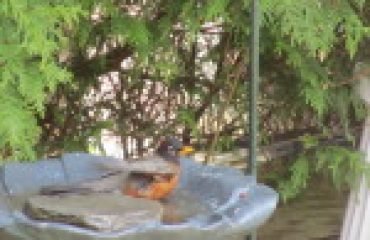Interesting!
While pondering upon an idea for my next posting… my supportive husband sent me the link below…“It popped up on Google news this morning… might interest you, a possible subject for your blog.”
I’m not a scientist, nor am I a child psychologist however, I would like to contribute my thoughts on these findings.
“Researchers have warned against teaching children about the real world with books that feature animals with human characteristics, as it not only leads to less factual learning and influences their reasoning about animals. Scientists at University of Toronto also found that young readers are more likely to attribute human behaviors and emotions to animals when exposed to books with anthropomorphized animals than books depicting animals realistically. Lead author Patricia Ganea, Assistant Professor at the university, said that books that portray animals realistically lead to more learning and more accurate biological understanding. “We were surprised to find that even the older children in our study were sensitive to the anthropocentric portrayals of animals in the books and attributed more human characteristics to animals after being exposed to fantastical books than after being exposed to realistic books,” she said. The researchers advise parents and teachers to consider using a variety of informational and nonfiction books, and to use factual language when describing the biological world to young children.” —The study is published in the journal Frontiers in Psychology.
Alice in Wonderland by Charles Lutwidge Dodgson 1865
The Tale of Peter Rabbit by Beatrice Potter 1902
White Fang by Jack London 1906
The Wind in the Willow by Kenneth Graham 1908
The Animals of Farthing Wood by Colin Dann 1979
… and Redwall by Brian Jacques 1986
I grew up cherishing these books.
Do take note that these wonderful, heart-warming stories “portraying animals with human characteristics” were written during the Golden Age of children’s literature when children’s stories were luxuriously illustrated.
This period spanned from the 1860’s to the end of 1920.
As a child I loved reading these titles. Personally, they were treasured stories that took me far away to enchanted forests and mystical worlds laden with intelligent talking animals. I would bury myself into these books distancing myself from the real world. I wanted to be a part of this magical fictional world.
As I grew older my perception of the books changed. I began to question why animals were portrayed with human attributes. All that changed during motherhood. I was once again drawn back into my favorite stories seeing the same stories in a different light; as seen by my children. What can I say; they loved it as much as I loved reading these books to my children.
I’m much older and wiser, I am a children’s writer. I write stories with animals, giving them human attributes because children love stories with animals especially a talking one.
Now touching on the same topic but on a different note; teaching children about the real world of animals should encompasses hiking trips, animal sanctuary where injured animals are cared for, trips to SPCA but not limited to these; and for a more biological aspect into the deep realistic world of the animal kingdom there is always Discovery Channel and Animal Planet and Nat Geo. Children know more than adults where to draw the distinction between a talking mouse and the rodent in their kitchen – if they have one.
There is a huge difference between watching Sponge Bob (I’m addicted to it), visiting Marineland and watching the wildlife in Cape Cod.
Teachers and parents should know how to approach a situation realistically. Real life situations can be related to Franklin the Turtle. If you ask a three year old if a turtle can ride a bike he would most definitely say no. These books were written to influence the reasoning of a child to relate to human attributes and children do relate well to animals and other children. They have a sense of security knowing they are not alone with their feelings.
It’s pure common sense to use non-fictional books to introduce children to the world of animals. Since television is widely used in our schools it’s never too early for educators to introduce the students to Sir David Attenborough or the Kratt brothers.
I love Arthur by Marc Brown, however I wouldn’t teach a child about an aardvark using the Arthur series. Arthur is Arthur; he is just the boy next door who loves to read. No one even cares what animal Francine portrays. Children articulate their feelings by relating to situations other children go through and by relating to anthropomorphized animals.
This mom and children’s writer thinks it’s in their genetic make up.
Keep writing and ask me how I can help you.




You must be logged in to post a comment.